Hydrological Modelling Using a Rainfall Simulator over an Experimental Hillslope Plot
Abstract
:1. Introduction
2. Materials and Methods
2.1. Study Area
2.2. Rainfall Simulator Design
2.3. Experimental Setup and Investigations
2.3.1. Raindrop Size Estimation
2.3.2. Performance Evaluation of Rainfall Simulator
2.3.3. Estimation of Kinetic Energy and Velocity of Rainfall
2.3.4. Soil Macropore Characteristics
3. Hydrological Modeling
Mathematical Framework of Hillslope Hydrological Model
- (1)
- Storage of water in the main bypass domain of macropore Smb (cm);
- (2)
- Infiltration of water into macropores at the soil surface, by precipitation, irrigation and snowmelt water falling directly into macropores Ipr and by overland flow (runoff) into the macropores Iru (cm/d);
- (3)
- Lateral infiltration into the unsaturated soil matrix Qlu (cm/d);
- (4)
- Lateral exfiltration out of the saturated soil matrix Qls (cm/d);
- (5)
- Lateral exfiltration out of the saturated soil matrix by interflow out of a zone with perched groundwater Qli (cm/d).
4. Results and Discussion
4.1. Field Observations
4.1.1. Study of Soil Moisture Profile in the Hillslope Plot
4.1.2. Results of Dye Pattern Analysis
4.1.3. Subsurface Flow Observation
4.1.4. Overland Flow Observation
4.2. Hydrological Modeling Results
4.3. Water Balance Analysis
5. Summary and Conclusions
Acknowledgments
Author Contributions
Conflicts of Interest
References
- Band, L.E.; Patterson, P.; Nemani, R.; Running, S.W. Forest ecosystem processes at the watershed scale: Incorporating hillslope hydrology. Agric. For. Meteorol. 1993, 63, 93–126. [Google Scholar] [CrossRef]
- Nolan, S.C.; van Vliet, L.J.P.; Goddard, T.W.; Flesch, T.K. Estimating storm erosion with a rainfall simulator. Can. J. Soil Sci. 1997, 77, 669–676. [Google Scholar] [CrossRef]
- Beven, K.J.; Germann, P.J. Macropores and water flow in soils. Water Resour. Res. 1982, 18, 1311–1325. [Google Scholar] [CrossRef]
- Shougrakpam, S.; Sarkar, R.; Dutta, S. An experimental investigation to characterize soil macroporosity under different land use and land covers of northeast India. J. Earth Syst. Sci. 2010, 119, 655–674. [Google Scholar] [CrossRef]
- Yvonne, S.; Martine, J.; Ploeg, V.D.; Teuling, A.J. Rainfall Simulator Experiments to Investigate Macropore Impacts on Hillslope Hydrological Response. Hydrology 2016, 3, 39. [Google Scholar]
- Adams, R.; Parkin, G.; Rutherford, J.C.; Ibbitt, R.P.; Elliott, A.H. Using a rainfall simulator and a physically based hydrological model to investigate runoff processes in a hillslope. Hydrol. Process. 2005, 19, 2209–2223. [Google Scholar] [CrossRef]
- Sheridan, G.J.; Noske, P.; Lane, P.; Sherwin, C. Using rainfall simulation and site measurements to predict annual interrill erodibility and phosphorus generation rates from unsealed forest roads: Validation against in-situ erosion measurements. CATENA 2008, 73, 49–62. [Google Scholar] [CrossRef]
- Arnaez, J.; Lasanta, T.; Ruiz-Flaño, P.; Ortigosa, L. Factors affecting runoff and erosion under simulated rainfall in Mediterranean vineyards. Soil Tillage Res. 2007, 93, 324–334. [Google Scholar] [CrossRef]
- Verbist, K.; Cornelis, W.M.; Gabriels, D.; Alaerts, K.; Soto, G. Using an inverse modelling approach to evaluate the water retention in a simple water harvesting technique. Hydrol. Earth Syst. Sci. 2009, 13, 1979–1992. [Google Scholar] [CrossRef]
- Humphry, J.B.; Daniel, T.C.; Edwards, R.D.; Sharpley, A.N. A portable rainfall simulator for plot scale runoff studies. Appl. Eng. Agric. 2002, 18, 199–204. [Google Scholar] [CrossRef]
- Sousa Júnior, S.F.; Siqueira, E.Q. Development and Calibration of a Rainfall Simulator for Urban Hydrology Research. In Proceedings of the 12th Intenational Conference on Urban Drainage, Porto/Alegre, Brazil, 11–16 September 2011.
- Pe’ rez-Latorre, F.J.; Castro, L.; Delgado, A. A comparison of two variable intensity rainfall simulators for runoff studies. Soil Tillage Res. 2010, 107, 11–16. [Google Scholar] [CrossRef]
- Abudi, I.; Carmi, G.; Berliner, P. Rainfall simulator for field runoff studies. J. Hydrol. 2012, 454–455, 76–81. [Google Scholar] [CrossRef]
- Bubenzer, G.D. Inventory of rainfall simulators. In Proceedings of the Workshop on Rainfall Simulators; Agricultural Research, Science and Education Agency, USDA: Washington, DC, USA, 1979; pp. 120–130. [Google Scholar]
- Meyer, L.D.; McCune, D.L. Rainfall simulator for runoff plots. Agric. Eng. 1958, 39, 644–648. [Google Scholar]
- Swanson, N.P. Rotating–boom rainfall simulator. Trans. ASAE 1965, 8, 71–72. [Google Scholar] [CrossRef]
- Foster, G.R.; Neibling, W.H.; Natterman, R.A. A Programmable Rainfall Simulator; American Society Agricultural Engineers: St. Joseph, MI, USA, 1982. [Google Scholar]
- Moore, I.D.; Hirschi, M.C.; Barfield, B.J. Kentucky rainfall simulator. Trans. ASAE 1983, 26, 1085–1089. [Google Scholar] [CrossRef]
- Shelton, C.H.; von Bernuth, R.D.; Rajbhandari, S.P. A continuous–application rainfall simulator. Trans. ASAE 1985, 28, 1115–1119. [Google Scholar] [CrossRef]
- Miller, W.P. A solenoid–operated, variable intensity rainfall simulator. Soil Sci. Soc. Am. J. 1987, 51, 832–834. [Google Scholar] [CrossRef]
- Meyer, L.D. Simulator of rainfall for soil erosion research. Trans. ASAE 1965, 8, 63–65. [Google Scholar] [CrossRef]
- Moore, I.D. Effect of surface sealing on infiltration. Trans. ASAE 1981, 24, 1547–1552. [Google Scholar] [CrossRef]
- Kathiravelu, G.; Lucke, T.; Nichols, P. Rain drop measurement techniques: A review. Water 2016, 8. [Google Scholar] [CrossRef]
- Hudson, N.W. The Influence of Rainfall on the Mechanics of Soil Erosion with Particular Reference to Southern Rhodesia, Unpub. Master’s Thesis, University of Cape Town, Cape Town, South Africa, 1965. [Google Scholar]
- Kara, T.; Ekmekci, E.; Apan, M. Determining the Uniformity Coefficient and Water Distribution Characteristics of Some Sprinklers. Pak. J. Biol. Sci. 2008, 11, 214–219. [Google Scholar] [CrossRef] [PubMed]
- Grierson, I.T.; Oades, J.M. A rainfall simulator for field studies of rainfall and runoff. J. Agric. Res. 1977, 22, 37–44. [Google Scholar]
- Wischmeier, W.H.; Smith, D.D. Rainfall energy and its relation to soil loss. Trans. Am. Geophys. Union 1958, 39, 285–291. [Google Scholar] [CrossRef]
- Lows, J.O.; Parson, D.A. The relationship of raindrop size to intensity. Trans. Am. Geophys. Union 1943, 24, 452–460. [Google Scholar] [CrossRef]
- Weiler, M.; Flühler, H. Inferring flow types from dye patterns in macroporous soils. Geoderma 2004, 120, 137–153. [Google Scholar] [CrossRef]
- Dutta, S.; Zade, M. RISE-A Distributed Hydrologic Model for Rice Agriculture: Concept and Evaluation. In Watershed Hydrology; Singh, V.P., Yadava, R.N., Eds.; Allied Publisher: New Delhi, India, 2003; pp. 240–251. [Google Scholar]
- Agnese, A.; Baiamonte, G.; Corrao, C. A simple model of hillslope response for overland flow generation. Hydrol. Process. 2001, 15, 3225–3238. [Google Scholar] [CrossRef]
- Anderson, S.P.; Dietrich, W.E.; Montgomery, D.R.; Torres, R.; Conrad, M.E.; Loague, K. Subsurface flow paths in a steep unchanneled catchment. Water Resour. Res. 1997, 33, 2637–2653. [Google Scholar] [CrossRef]
- Horton, R.E. The role of infiltration in the hydrological cycle. Trans. Am. Geophys. Union 1933, 14, 446–460. [Google Scholar] [CrossRef]
- Freeze, R.A. Role of subsurface flow in generating surface runoff. 2. Upstream source areas. Water Resour. Res. 1972, 8, 1273–1283. [Google Scholar] [CrossRef]
- Dunne, T. Field studies of hillslope processes. In Hillslope Hydrology; Kirkby, M.J., Ed.; McGraw-Hill: New York, NY, USA, 1978; pp. 227–293. [Google Scholar]
- Kroes, J.G.; van Dam, J.C.; Groenendijk, P.; Hendriks, R.F.A.; Jacobs, C.M.J. SWAP Version 3.2. Theory Description and User Manual; Alterra Report 1649; Alterra: Wageningen, The Netherlands, 1964. [Google Scholar]
- Shakya, N.M.; Chander, S. Modelling of hillslope runoff processes. Environ. Geol. 1998, 35, 115. [Google Scholar] [CrossRef]
- Knasiak, K.; Schick, R.J.; Kalata, W. Multiscale Design of Rain Simulator. In Proceedings of the 20th Annual Conference on Liquid Atomization and Spray Systems, Chicago, IL, USA, 15–18 May 2007.
- Nash, J.E.; Sutcliffe, J.V. River flow forecasting through conceptual models part I—A discussion of principles. J. Hydrol. 1970, 10, 282–290. [Google Scholar] [CrossRef]
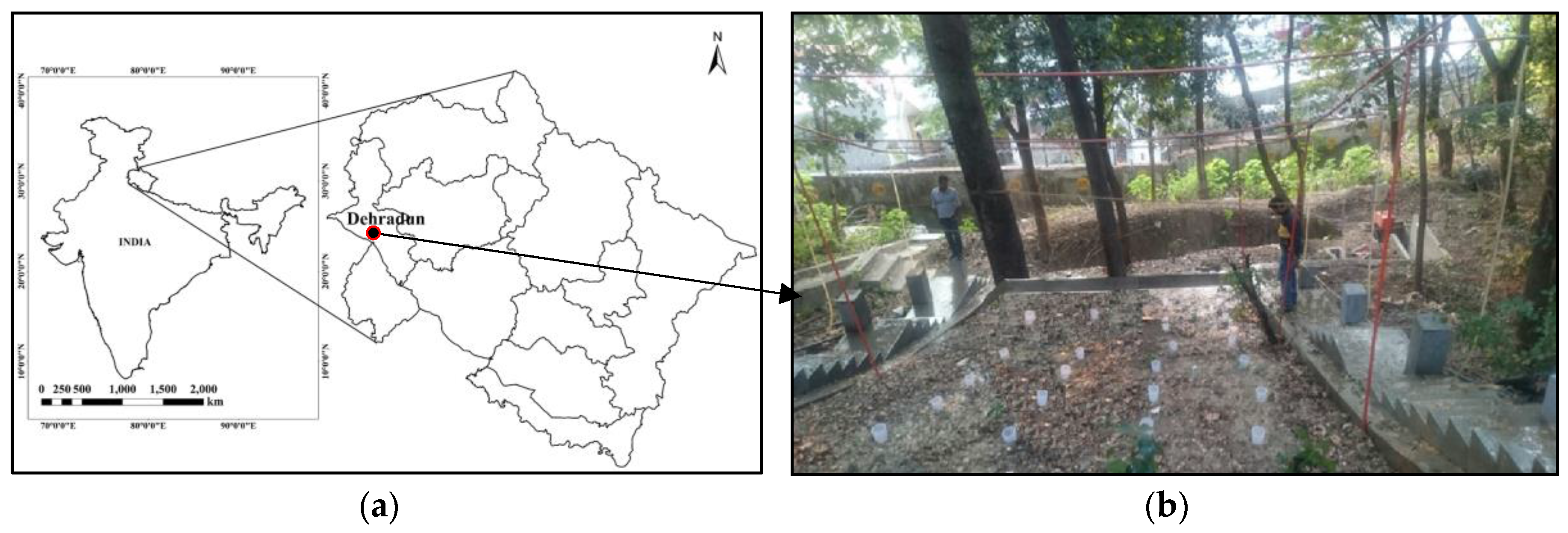
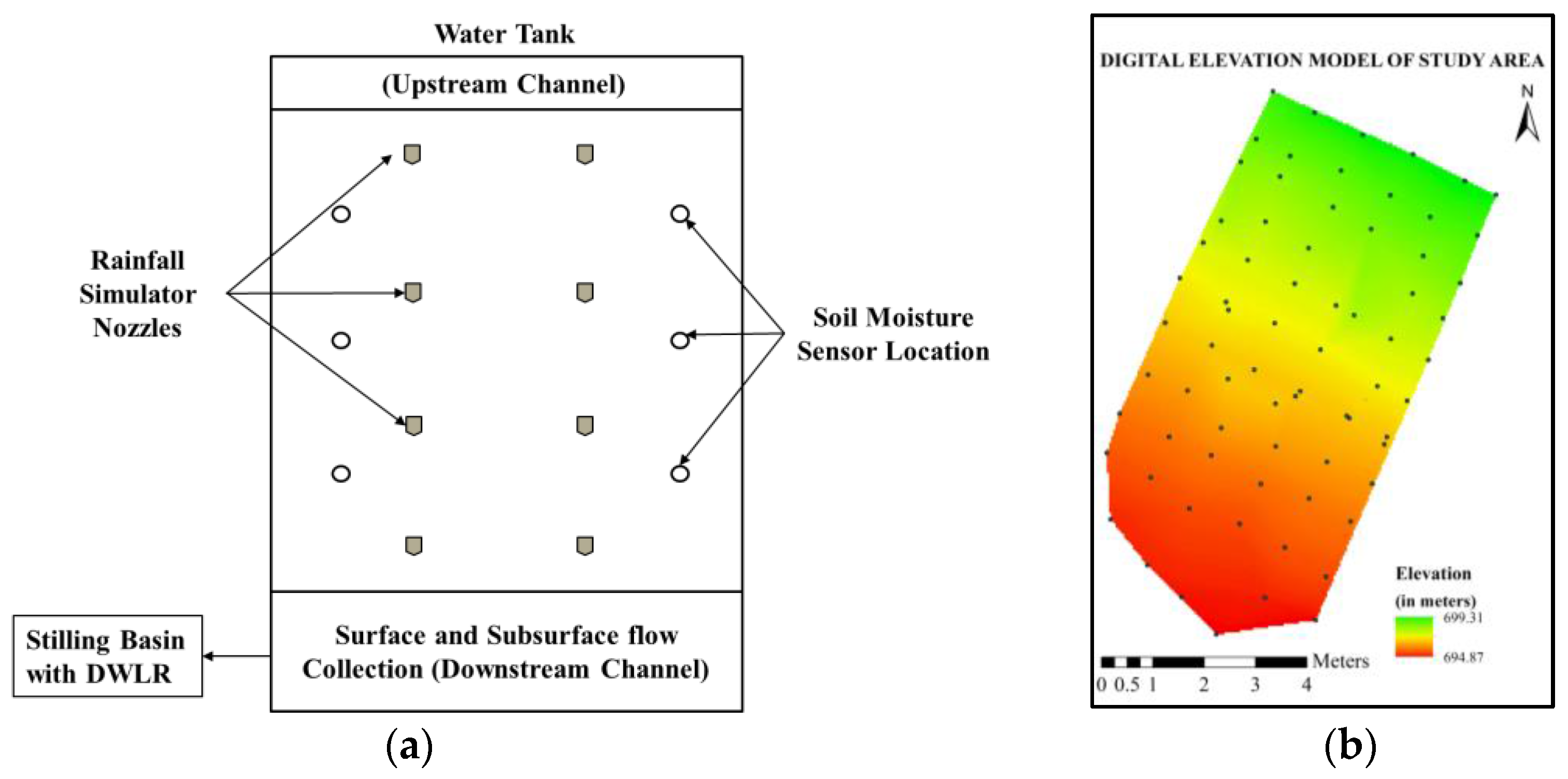
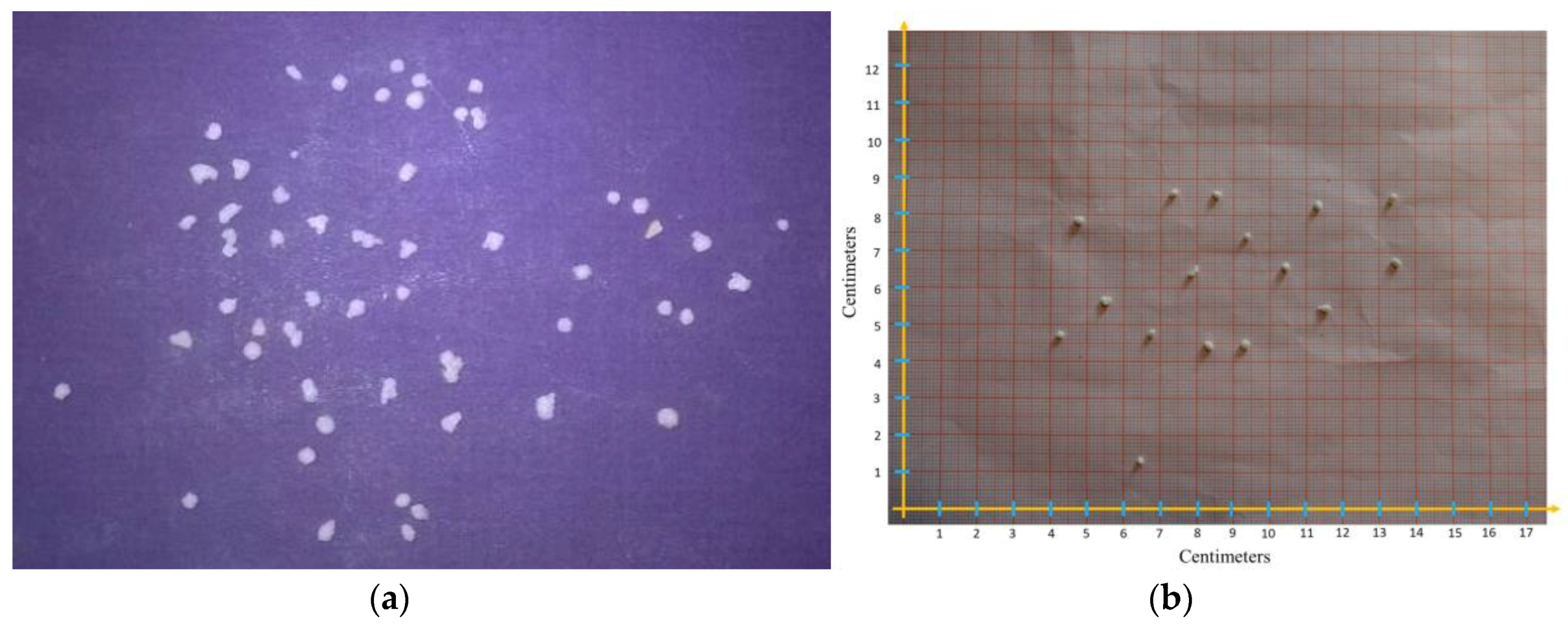

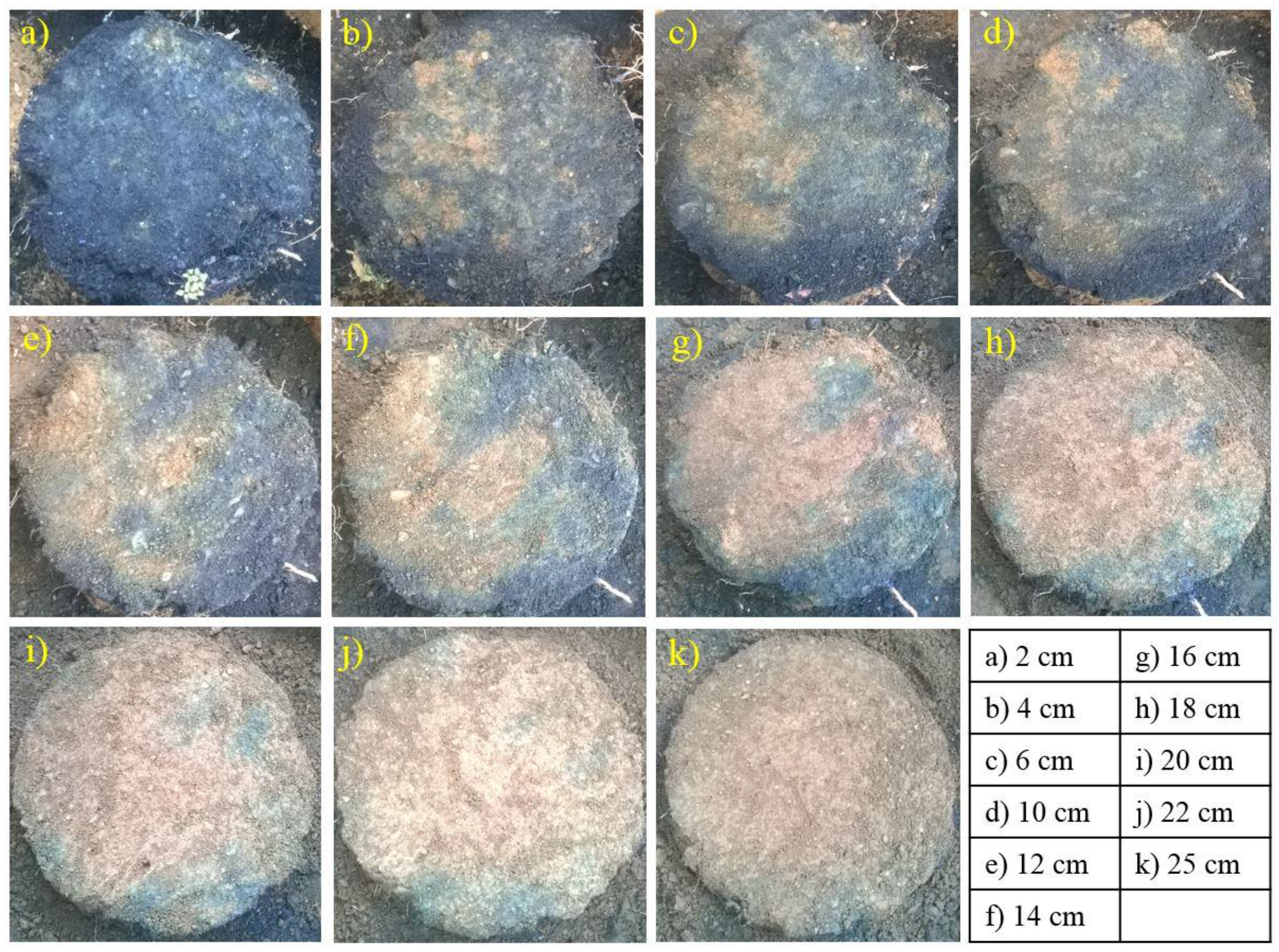

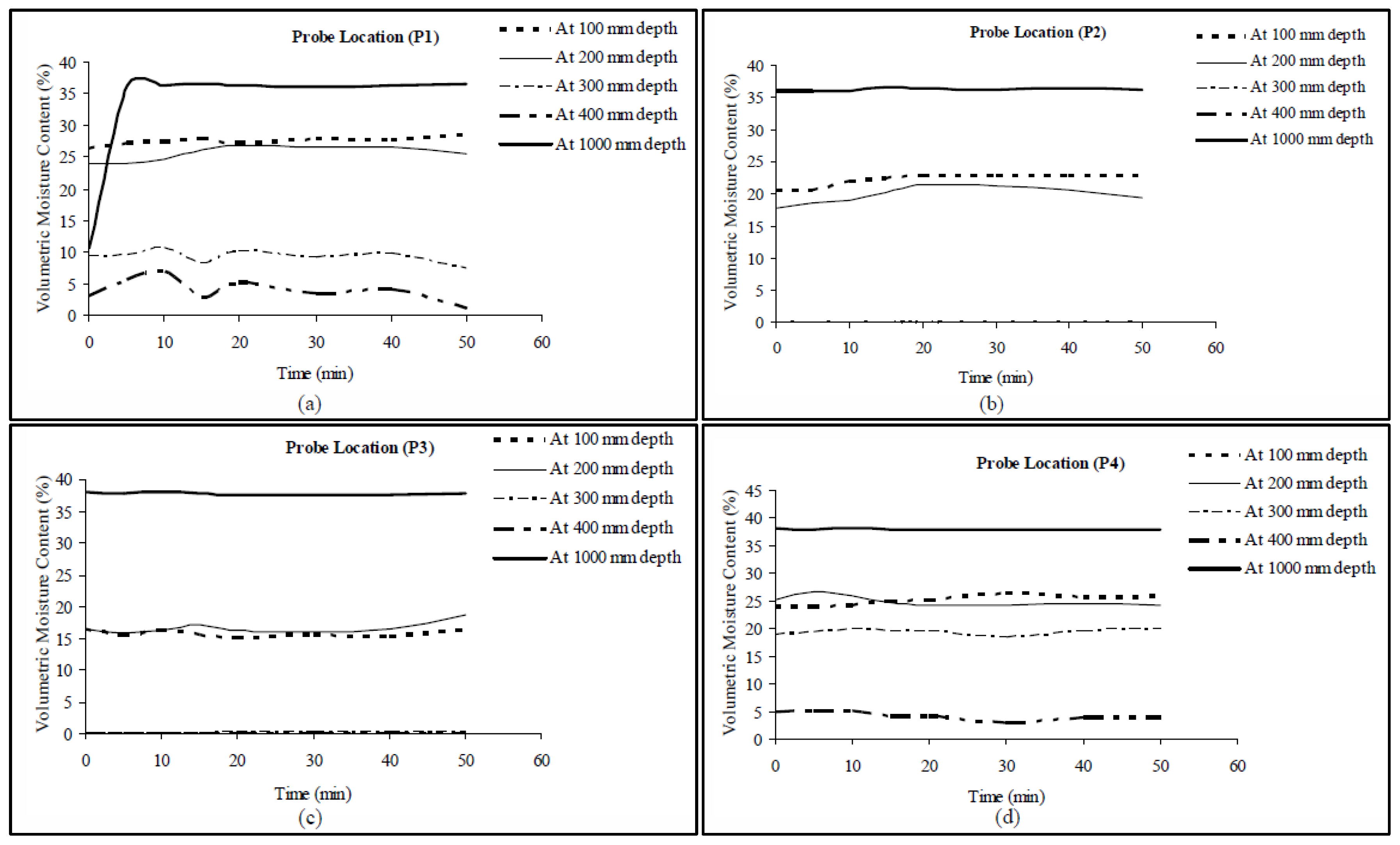



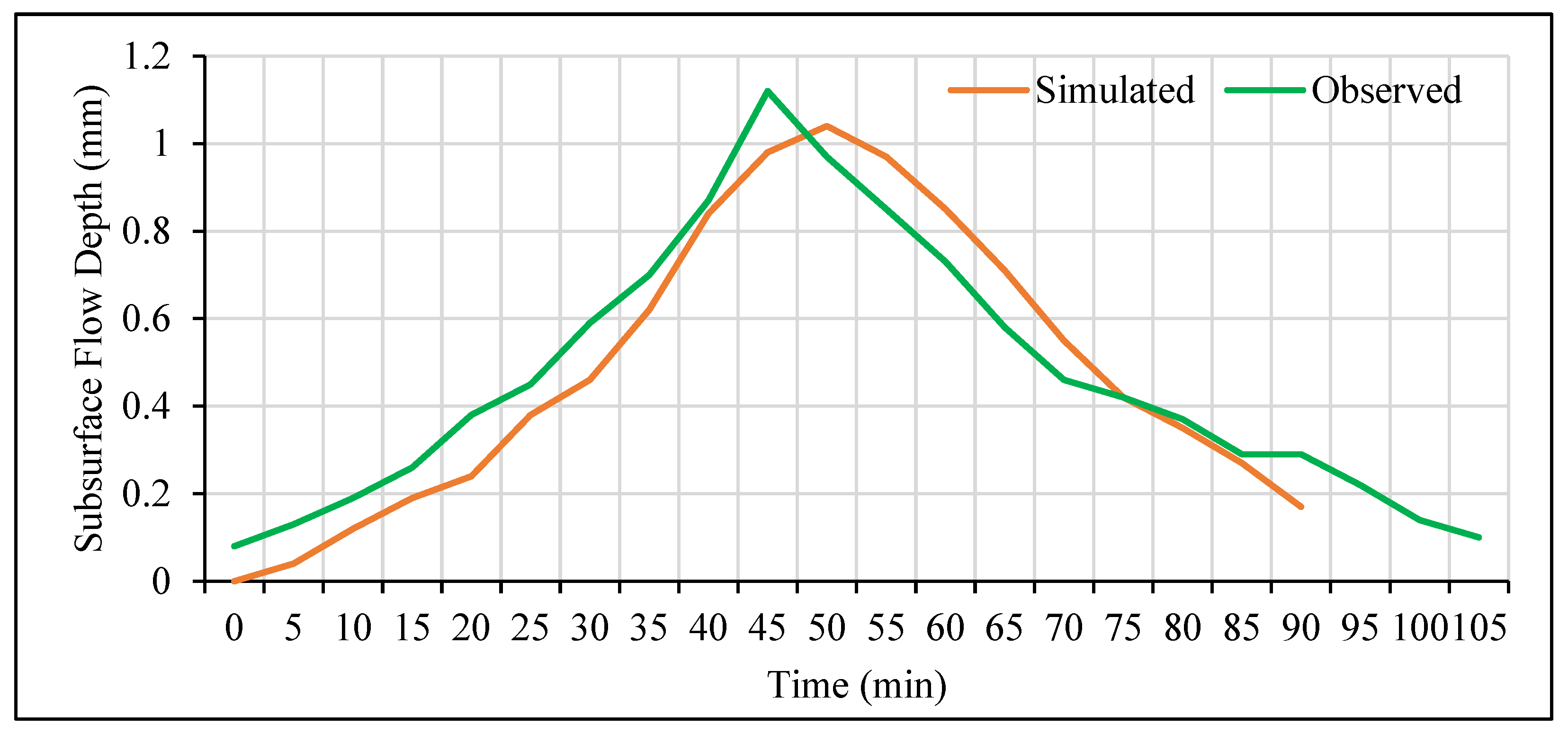
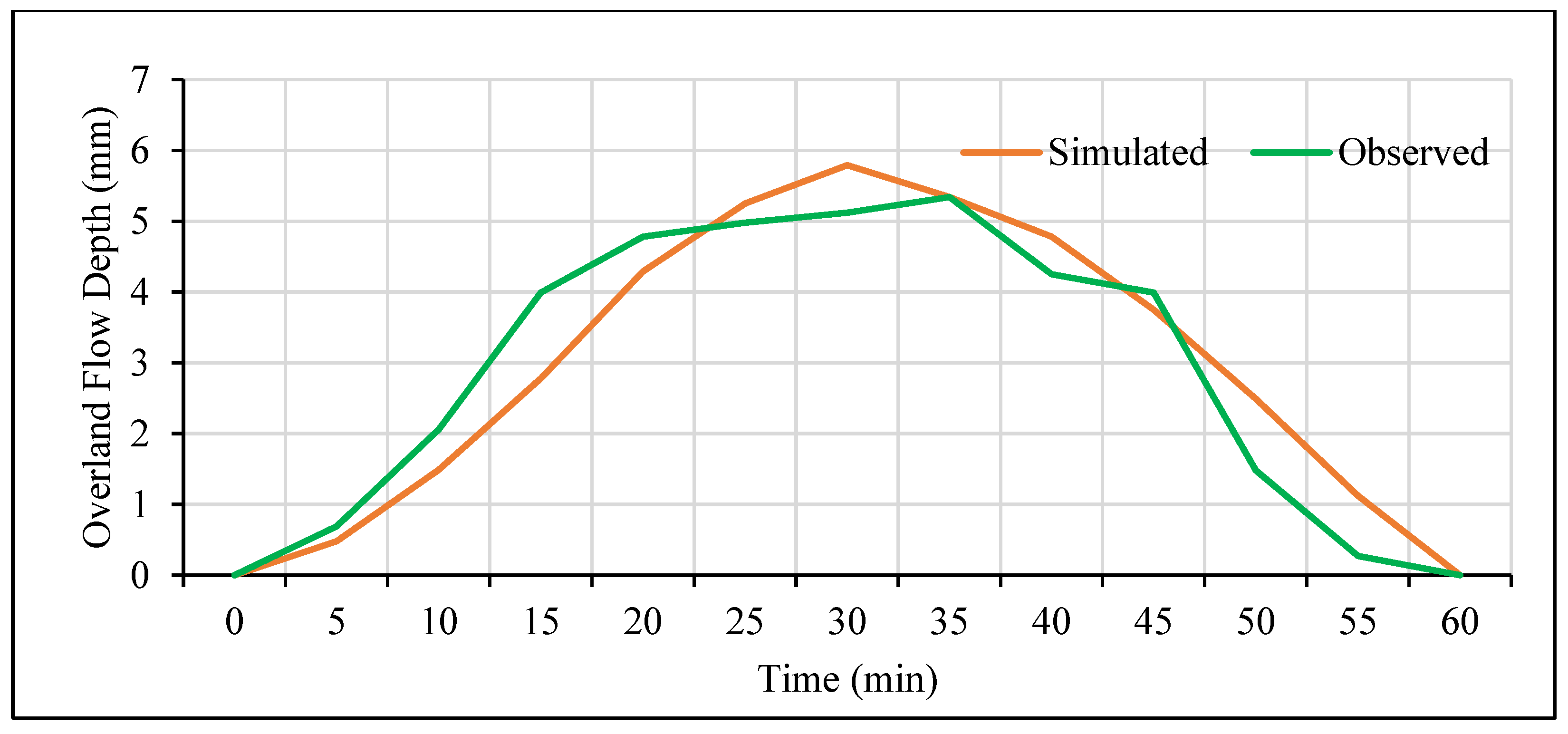
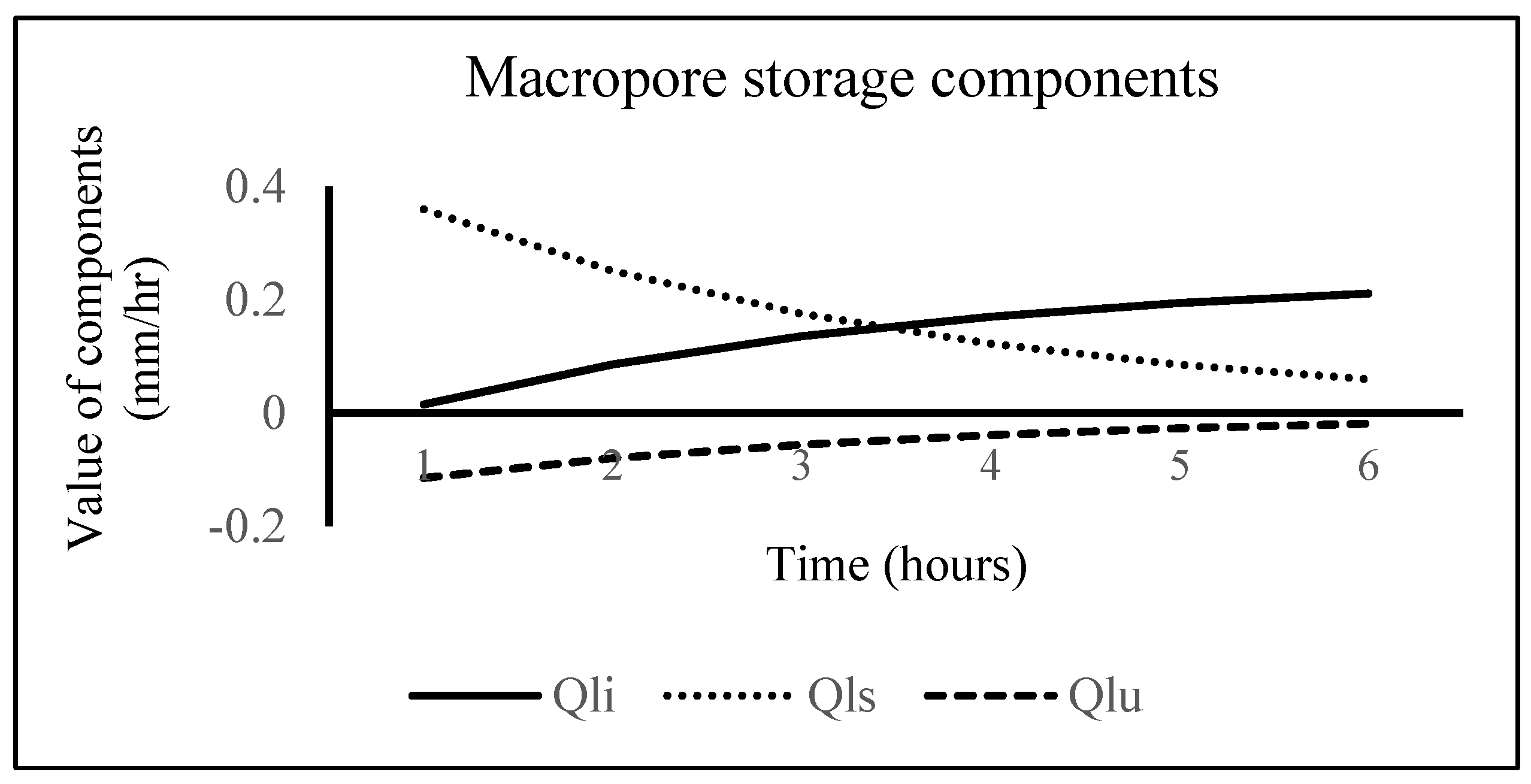
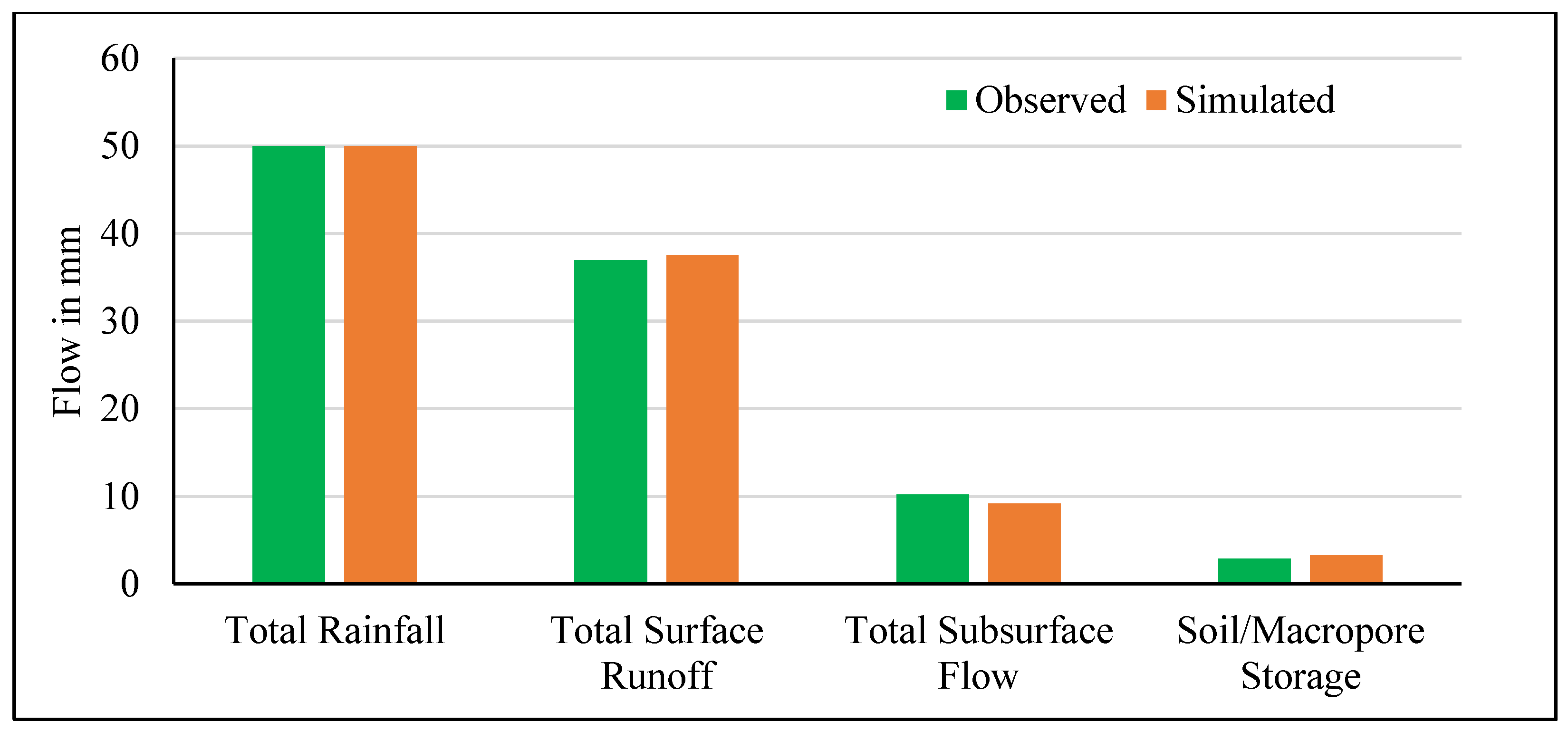
| Soil Layer | Texture | % Sand | % Silt | % Clay | Bulk Density (g/cm3) |
|---|---|---|---|---|---|
| Top Layer (0–10 cm) | Loamy Sand | 78.68 | 12.74 | 8.66 | 1.450 |
| Bottom Layer (10–30 cm) | Loam | 49.12 | 43.44 | 7.44 | 1.527 |
| Drop Diameter (mm) | Terminal Velocity (m/s) | Velocity (m/s) Measured |
|---|---|---|
| 1 | 4 | 3.3 |
| 1.5 | 5.3 | 4 |
| 2 | 6.5 | 5 |
| 2.5 | 7.2 | 5.7 |
| 3 | 8 | 6.2 |
| 3.5 | 8.5 | 6 |
| more | ≤9 | - |
© 2017 by the authors. Licensee MDPI, Basel, Switzerland. This article is an open access article distributed under the terms and conditions of the Creative Commons Attribution (CC BY) license ( http://creativecommons.org/licenses/by/4.0/).
Share and Cite
Chouksey, A.; Lambey, V.; Nikam, B.R.; Aggarwal, S.P.; Dutta, S. Hydrological Modelling Using a Rainfall Simulator over an Experimental Hillslope Plot. Hydrology 2017, 4, 17. https://doi.org/10.3390/hydrology4010017
Chouksey A, Lambey V, Nikam BR, Aggarwal SP, Dutta S. Hydrological Modelling Using a Rainfall Simulator over an Experimental Hillslope Plot. Hydrology. 2017; 4(1):17. https://doi.org/10.3390/hydrology4010017
Chicago/Turabian StyleChouksey, Arpit, Vinit Lambey, Bhaskar R. Nikam, Shiv Prasad Aggarwal, and Subashisa Dutta. 2017. "Hydrological Modelling Using a Rainfall Simulator over an Experimental Hillslope Plot" Hydrology 4, no. 1: 17. https://doi.org/10.3390/hydrology4010017
APA StyleChouksey, A., Lambey, V., Nikam, B. R., Aggarwal, S. P., & Dutta, S. (2017). Hydrological Modelling Using a Rainfall Simulator over an Experimental Hillslope Plot. Hydrology, 4(1), 17. https://doi.org/10.3390/hydrology4010017





